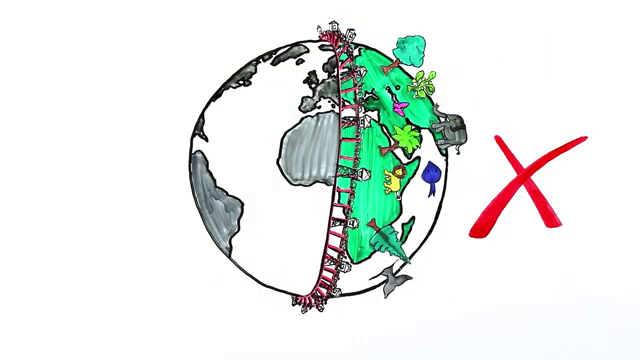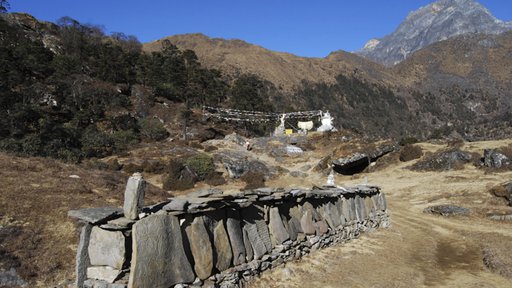
30% by 2030: The “Global Deal For Nature”
Why we should critique it and what the alternatives are
"Half Earth" is an idea first introduced by U.S. biologist E.O.Wilson – who is famous for developing the very concept of biodiversity. In his 2016 book "Half Earth. A Planet Fights for Its Life" he popularized the claim that "Nature Needs Half" of the planet's surface to thrive. This idea is problematic. In the book Wilson calls for half of the Earth's surface to be designated as protected areas in order to prevent destructive influence of humans on non-human species. Wilson's claims that protected areas are efficient to spatially restrict destructive industries and that there are simply not enough of those areas. In his book he strongly generalizes "humanity" and omits the differences between societies and cultures, denying humans the ability to live in harmony with non-human nature, even though Indigenous groups actually do that. Instead of transforming the economic system which drives destruction of living species, he wants to spatially separate humans from nature. However, water or air pollution would never stay on one "side" and there is no description in his book what life would look like on the human side.
The idea that the sixth mass extinction of biodiversity could be stopped through a massive expansion of "protected areas" is also gaining support at the policy level. UN bodies such as the CBD (Convention on Biological Diversity) and IUCN (International Union for Conservation of Nature) are discussing to place 30% of the Earth's surface under protection by 2030 - that would include both terrestrial and marine ecosystems. Campaigns such as the "New/Global Deal for Nature and People" are intended to raise awareness and encourage policymakers to implement these ideas quickly. This November, at the CBD's 15th COP (Conference of the Parties) in China "30x30" is expected to be adopted and many countries have already voiced support for the goal.
Action is urgently needed to safeguard biodiversity. However, good intentions and declarations are of no use if they are not implemented. For the decade from 2010 to 2020 the UN set itself 20 biodiversity targets and achieved none of them. Even a rich global North nation like Germany only achieved one of the 20 goals and 1/3 of the mammal species are on the red list of endangered species. Apart from implementation problems the "30x30" idea is criticized by Indigenous communities, numerous organizations from the Global South and scientists for a range of other reasons: They fear local people could be evicted from land they inhabited for thousands of years only to create protected areas. Indigenous communities have proven to effectively safeguard biodiversity on their land and the best conservation measure is to guarantee their land rights. Conservation should never lead to human rights violations which has happened in the past and still continues today, particularly when protected areas are cordoned off by armed eco-guards. The critics demand that local and Indigenous communities must have the power to decide what happens on their land. This includes their free, prior and informed consent to any projects carried out.


However, there are many alternative approaches that successfully combine human rights and effective nature conservation. ICCAs (Indigenous Community Conservation Areas) or "Territories Of Life" are areas which belong to Indigenous communities, which are lived in and managed by them and allow them to continue obtaining their livelihoods. Similarly, in Europe most nature parks or landscape protected areas are inhabited and people also continue to practice agriculture. "Rights Of Nature" is a legal concept originating in Indigenous Cosmologies which emphasizes Natures inherent value and therefore criminalizes the destruction of it. Convivial Conservation challenges the separation of "pristine wilderness" and human culture through protected areas. It promotes humans living from and with nature but ending industries and activities which destroy biodiversity everywhere. Such approaches could be at least partially integrated into existing concepts of nature conservation and protected areas - e.g. ICCAs can be recognized as "Other effective area-based conservation measures".
Biodiversity conservation is only possible if the economic system changes fundamentally and industrial societies in particular reduce their consumption of materials and energy. We must take responsibility for the problems economic growth is causing - both in the industrialized countries of the EU, but also in other countries. We must not offload the "saving" of biodiversity onto communities that contribute little to the problems of species loss. Transforming the economic system to a degrowth/post-growth economy along with decolonization is necessary to create systems to guarantee the livelihoods of people and sustain nature. Even though it is not easy to fundamentally change the deadlocked systems that currently dominate our world, many people are setting out to do so.
Sources
We would like to share the materials collected on this page in a spirit of support and solidarity.
As a small group, we unfortunately do not have the capacity to research all the contacts and contact the authors, creators and contributors of the materials listed on this page and to ask them explicitly for their permission, to be linked in this context.
If you are the author, creator, or contributor of any of these materials of any of these materials and do not consent to their use in this context, please let us know at presse(at)extinctionrebellion.de and we will remove it.
VIDEOS/AUDIO
Hugh Govan and Mohammad Arju: Conversation of the controversy of 30×30 Campaign
hosted by the ICCA Consortium
ARTICLES
Wall Street International, Ashish Kothari: Colonial conservation in new avatars
Good overview by Ashish Kothari on what is wrong with the idea of "half earth" and the new UN proposals and also what could be done better and which initiatives exist
World Rainforest Movement: The Conservation Industry’s Agenda in Times of Crisis
Expanding protected areas to 30% in the Global Deal for Nature: A colonialist anti-people approach and it allows the "destruction of forests and biodiversity to continue, both within and beyond their limits".
"The call for more Protected Areas addresses neither the root causes of destruction nor does it tackle the threats to which Indigenous peoples and peasant and traditional communities are exposed as a result of this destruction."
For centuries Indigenous communities have remained responsible stewards for biodiversity protection. But today their voices are being ignored.
SDG Knowledge Hub: Scientists Call for Protecting 30 Percent of Lands by 2030
" The Global Deal for Nature calls for protecting at least 30 percent of lands by 2030, with an additional 20 percent of land protected as climate stabilization areas. " -> but there and how should those be established?
Medium, Chris Lang: Half-earth or whole earth?
Survival, Minority Rights Group and 130 others opposing the 30x2030 proposal
Easy to read letter/ critique of 30x2030 by a diverse group of academics. Enough detail and excellent sum-up
This critique quotes the paper "Protecting half of the planet could directly affect over one billion people" and goes a bit more in detail on the scale of possible displacement
Mongabay, Liz Kimbrough: Human rights-based conservation is key to protecting biodiversity: Study
Seems the Campaign For Nature (30x30) remembered human rights and worked on a study looking at those connected with the expansion of conservation areas. To "adopt rights-based conservation approaches" sounds good, but if the new Global Biodiversity framework will truly center the rights of Indigenous Peoples is highly doubtable.
CounterPunch, Stephen Corry: New Deal for Nature: Paying the Emperor to Fence the Wind
In-depth reading:
CBD: EXECUTIVE SUMMARY OF THE REPORT OF THE SECOND BOGIS-BOSSEY DIALOGUE FOR BIODIVERSITY
plans of the Convention for Biological Diversity (CBD) for the upcoming talks
Waldron Report: Protecting 30% of the planet for nature: costs, benefits and economic implications
The Waldron et. Al. report criticized by the Open Letter: Working paper analysing the economic implications of the proposed 30% target for areal protection in the draft post-2020 Global Biodiversity Framework